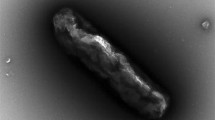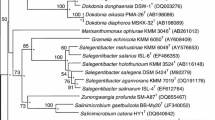Abstract
A novel marine bacterium, designated KMU-57T, was isolated from seawater collected from the Republic of Korea, and it was characterized using polyphasic taxonomic methods. Strain KMU-57T was Gram-stain-negative, strictly aerobic, rod-shaped, motile and dark-yellow-pigmented. Comparative analysis based on the 16S rRNA gene sequence showed the affiliation of the isolate with members of the family Flavobacteriaceae of the phylum Bacteroidetes, and it had the greatest sequence similarity (97.6%) to Lacinutrix jangbogonensis PAMC 27137T. The DNA–DNA relatedness value between strain KMU-57T and L. jangbogonensis PAMC 27137T was 37.8 ± 2.2%. The DNA G + C content of strain KMU-57T was 29.9 mol%; MK-6 was the major menaquinone with; iso-C15:1 G (18.6%) and C16:1 ω7c and/or C16:1 ω6c (15.8%) as the major (> 10%) cellular fatty acids. The polar lipid profile consisted of phosphatidylethanolamine, three unidentified aminolipids, and five unidentified lipids. The strain represents a novel species of the genus Lacinutrix for which the name Lacinutrix salivirga sp. nov. is proposed. The type strain of L. salivirga sp. nov. is KMU-57T (= KCTC 52878T = NBRC 112845T).


Similar content being viewed by others
References
Alonso C, Warnecke F, Amann R, Pernthaler J (2007) High local and global diversity of flavobacteria in marine plankton. Environ Microbiol 9:253–266
Bernardet JF, Nakagawa Y, Holmes B (2002) Proposed minimal standards for describing new taxa of the family Flavobacteriaceae and emended description of the family. Int J Syst Evol Microbiol 52:1049–1070
Bowman JP, Nichols DS (2005) Novel members of the family Flavobacteriaceae from Antarctic maritime habitats including Subsaximicrobium wynnwilliamsii gen. nov., sp. nov., Subsaximicrobium saxinquilinus sp. nov., Subsaxibacter broadyi gen. nov., sp. nov., Lacinutrix copepodicola gen. nov., sp. nov., and novel species of the genera Bizionia, Gelidibacter and Gillisia. Int J Syst Evol Microbiol 55:1471–1486
Collins MD, Jones D (1981) A note on the separation of natural mixtures of bacterial ubiquinones using reverse-phase partition thin-layer chromatography and high performance liquid chromatography. J Appl Bacteriol 51:129–134
Colwell RR (1970) Polyphasic taxonomy of the genus Vibrio: numerical taxonomy of Vibrio cholerae, Vibrio parahaemolyticus, and related Vibrio species. J Bacteriol 104:410–433
Felsenstein J (1985) Confidence limits on phylogenies: an approach using the bootstrap. Evolution 39:783–791
Fitch WM (1971) Towards defining the course of evolution: minimum change for a specific tree topology. Syst Zool 20:406–416
Garrity GM, Holt JG (2001) The road map to the manual. In: Boone DR, Castenholz RW, Garrity GM (eds) Bergey’s Manual of Systematic Bacteriology, vol 1, 2nd edn. Springer, New York, pp 119–166
Hansen GH, Sørheim R (1991) Improved method for phenotypical characterization of marine bacteria. J Microbiol Methods 13:231–241
Hertel C, Schmidt G, Fischer M, Oellers K, Hammes WP (1998) Oxygen-dependent regulation of the expression of the catalase gene katA of Lactobacillus sakei LTH677. Appl Environ Microbiol 64:1359–1365
Jooste PJ (1985) The taxonomy and significance of Flavobacterium–Cytophaga strains from dairy sources, Ph.D. thesis. University of the Orange Free State, South Africa
Kim H, Yoon SC, Choi KH, Kim ST, Lee JB, Kim DS, Han HL, Bae KS, Park DS (2017) Lacinutrix chionocetis sp. nov., isolated from gut of a red snow crab. Arch Microbiol 99:597–603
Kimura M (1980)) A simple method for estimating evolutionary rates of base substitutions through the comparative studies of sequence evolution. J Mol Evol 16:111–120
Kirchman DL (2002) The ecology of Cytophaga-Flavobacteria in aquatic environments. FEMS Microbiol Ecol 39:91–100
Komagata K, Suzuki K (1987) Lipid and cell-wall analysis in bacterial systematics. Meth Microbiol 19:161–207
Lane DJ (1991) 16S/23S rRNA sequencing. In: Stackebrandt E, Goodfellow M (eds) Nucleic acid techniques in bacterial systematics. Wiley, Chichester, pp 115–175
Lasa A, Diéguez AL, Romalde JL (2015) Description of Lacinutrix venerupis sp. nov.: a novel bacterium associated with reared clams. Syst Appl Microbiol 38:115–119
Lee YM, Hwang CY, Lee I, Jung YJ, Cho Y, Baek K, Hong SG, Kim JH, Chun J, Lee HK (2014) Lacinutrix jangbogonensis sp. nov., a psychrophilic bacterium isolated from Antarctic marine sediment and emended description of the genus Lacinutrix. Antonie Van Leeuwenhoek 106:527–533
Lewin RA, Lounsbery DM (1969) Isolation, cultivation and characterization of flexibacteria. J Gen Microbiol 58:145–170
Mesbah M, Premachandran U, Whitman WB (1989) Precise measurement of the G + C content of deoxyribonucleic acid by high-performance liquid chromatography. Int J Syst Bacteriol 39:159–167
Minnikin DE, O’Donnell AG, Goodfellow M, Alderson G, Athalye M, Schaal A, Parlett JH (1984) An integrated procedure for the extraction of bacterial isoprenoid quinines and polar lipids. J Microbiol Methods 2:233–241
Nedashkovskaya OI, Kwon KK, Yang SH, Lee HS, Chung KH, Kim SJ (2008) Lacinutrix algicola sp. nov. and Lacinutrix mariniflava sp. nov., two novel marine alga-associated bacteria and emended description of the genus Lacinutrix. Int J Syst Evol Microbiol 58:2694–2698
Nedashkovskaya OI, Kim SG, Zhukova NV, Lee JS, Mikhailov VV (2016) Lacinutrix cladophorae sp. nov., a flavobacterium isolated from the green alga Cladophora stimpsonii, transfer of Flavirhabdus iliipiscaria Shakeela et al. 2015 to the genus Lacinutrix as Lacinutrix iliipiscaria comb. nov. and emended description of the genus Lacinutrix. Int J Syst Evol Microbiol 66:4339–4346
O’Sullivan LA, Rinna J, Humphreys G, Weightman AJ, Fry JC (2006) Culturable phylogenetic diversity of the phylum ‘Bacteroidetes’ from river epilithon and coastal water and description of novel members of the family Flavobacteriaceae: Epilithonimonas tenax gen. nov., sp. nov. and Persicivirga xylanidelens gen. nov., sp. nov. Int J Syst Evol Microbiol 56:169–180
Power DA, Johnson JA (2009) Difco™ and BBL™ manual: manual of microbiological culture media, 2nd edn. Becton Dickinson and Company, Sparks, pp 359–360
Saitou N, Nei M (1987) The neighbor-joining method: a new method for reconstructing phylogenetic trees. Mol Biol Evol 4:406–425
Sasser M (1990) Identification of bacteria by gas chromatography of cellular fatty acids, MIDI Technical Note 101. MIDI Inc, Newark
Srinivas TN, Prasad S, Manasa P, Sailaja B, Begum Z, Shivaji S (2013) Lacinutrix himadriensis sp. nov., a psychrophilic bacterium isolated from a marine sediment, and emended description of the genus Lacinutrix. Int J Syst Evol Microbiol 63:729–734
Stackebrandt E, Goebel BM (1994) Taxonomic note: a place for DNA–DNA reassociation and 16S rRNA sequence analysis in the present species definition in bacteriology. Int J Syst Bacteriol 44:846–849
Suzuki K, Kaneko T, Komagata K (1981) Deoxyribonucleic acid homologies among coryneform bacteria. Int J Syst Bacteriol 31:131–138
Tamura K, Peterson D, Petersen N, Stecher G, Nei M, Kumar S (2011) MEGA5: Molecular evolutionary genetics analysis using Maximum Likelihood, evolutionary distance, and Maximum Parsimony methods. Mol Biol Evol 28:2731–2739
Thompson JD, Gibson TJ, Plewniak F, Jeanmougin F, Higgins DG (1997) The CLUSTAL_X windows interface: flexible strategies for multiple sequence alignment aided by quality analysis tools. Nucleic Acids Res 25:4876–4882
Worliczek HL, Kämpfer P, Rosengarten R, Tindall BJ, Busse HJ (2007) Polar lipid and fatty acid profiles-re-vitalizing old approaches as a modern tool for the classification of mycoplasmas? Syst Appl Microbiol 30:355–370
Yi H, Cho JC, Chun J (2012) Flavivirga jejuensis gen. nov., sp. nov., and Flavivirga amylovorans sp. nov., new members of the family Flavobacteriaceae isolated from seawater, and emended descriptions of the genera Psychroserpens and Lacinutrix. Int J Syst Evol Microbiol 62:1061–1068
Yoon J, Lee KC, Lee JS (2016) Cribrihabitans pelagius sp. nov., a marine alphaproteobacterium isolated from seawater. Int J Syst Evol Microbiol 66:3195–3200
Yoon SH, Ha SM, Kwon S, Lim J, Kim Y, Seo H, Chun J (2017)) Introducing EzBioCloud: a taxonomically united database of 16S rRNA and whole genome assemblies. Int J Syst Evol Microbiol 67:1613–1617
Zeng YX, Zhang F, He JF, Lee SH, Qiao ZY, Yu Y, Li HR (2013) Bacterioplankton community structure in the Arctic waters as revealed by pyrosequencing of 16S rRNA genes. Antonie Van Leeuwenhoek 103:1309–1319
Acknowledgements
The present research was supported by the Educational–Industrial Collaboration Research Grant of YOONSUNG Co. in 2017 and by a Grant from the Korea Research Institute of Bioscience and Biotechnology (KRIBB) Research Initiative Program.
Author information
Authors and Affiliations
Corresponding author
Ethics declarations
Conflict of interest
The authors declare that they have no conflict of interest.
Research involving human participants and/or animals
This article does not contain any studies with human participants or animals performed by any of the authors.
Additional information
Communicated by Erko Stackebrandt.
The digital protologue database (DPD) number for the strain KMU-57T is TA00347. The GenBank/EMBL/DDBJ accession number of the 16S rRNA gene sequence of strain KMU-57T is LC339518.
Electronic supplementary material
Below is the link to the electronic supplementary material.
203_2018_1533_MOESM1_ESM.pdf
Supplementary Fig. 1. A thin-layer chromatogram showing the total polar lipid compositions of KMU-57T. Total polar lipids were detected by spraying the plate with molybdatophosphoric acid. PE: phosphatidylethanolamine, AL: unidentified aminolipid, L: unidentified lipid (PDF 54 KB)
Rights and permissions
About this article
Cite this article
Yoon, J., Lee, JS. & Lee, KC. Description of Lacinutrix salivirga sp. nov., a marine member of the family Flavobacteriaceae isolated from seawater. Arch Microbiol 200, 1159–1165 (2018). https://doi.org/10.1007/s00203-018-1533-z
Received:
Revised:
Accepted:
Published:
Issue Date:
DOI: https://doi.org/10.1007/s00203-018-1533-z




